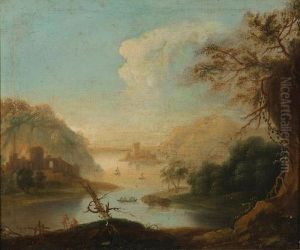Nicolas Boudewyns Paintings
Nicolas Boudewyns was a Flemish painter, draughtsman, and engraver, primarily known for his landscapes and marine scenes. Born around 1650, Boudewyns' exact birthplace is not well-documented, but it is believed that he was active in the art scene in Antwerp, a city renowned for its vibrant artistic community during the 17th century.
His work is characteristic of the Flemish Baroque period, which is known for its detailed realism, deep color, and emphasis on light and shadow. Boudewyns' landscapes often depicted the rural countryside of Flanders, featuring pastoral scenes with peasants and livestock, as well as views of rivers and ports that highlight the economic and maritime activities of the time.
Boudewyns was influenced by other Flemish artists like Jan Brueghel the Elder and younger, whose works were also centered around landscapes and the daily life of the people. He was particularly adept at capturing the changing seasons and the various activities associated with them, which was a popular theme among Flemish artists. His paintings often had a calm and serene atmosphere, with a meticulous attention to the naturalistic details of the scenery.
Throughout his career, Nicolas Boudewyns did not achieve the same level of fame as some of his contemporaries, and as a result, his works are less known today. However, his contributions to Flemish art are appreciated by art historians and collectors who recognize the quality and charm of his paintings. Despite the scarcity of biographical details, his artworks provide insight into the rural life and landscape of Flanders during the Baroque period.
Nicolas Boudewyns passed away in 1720. While the exact circumstances of his death are unclear, his artistic legacy remains through the quiet beauty captured in his landscapes and marine paintings, which continue to be studied and admired for their contribution to the Flemish Baroque tradition.
